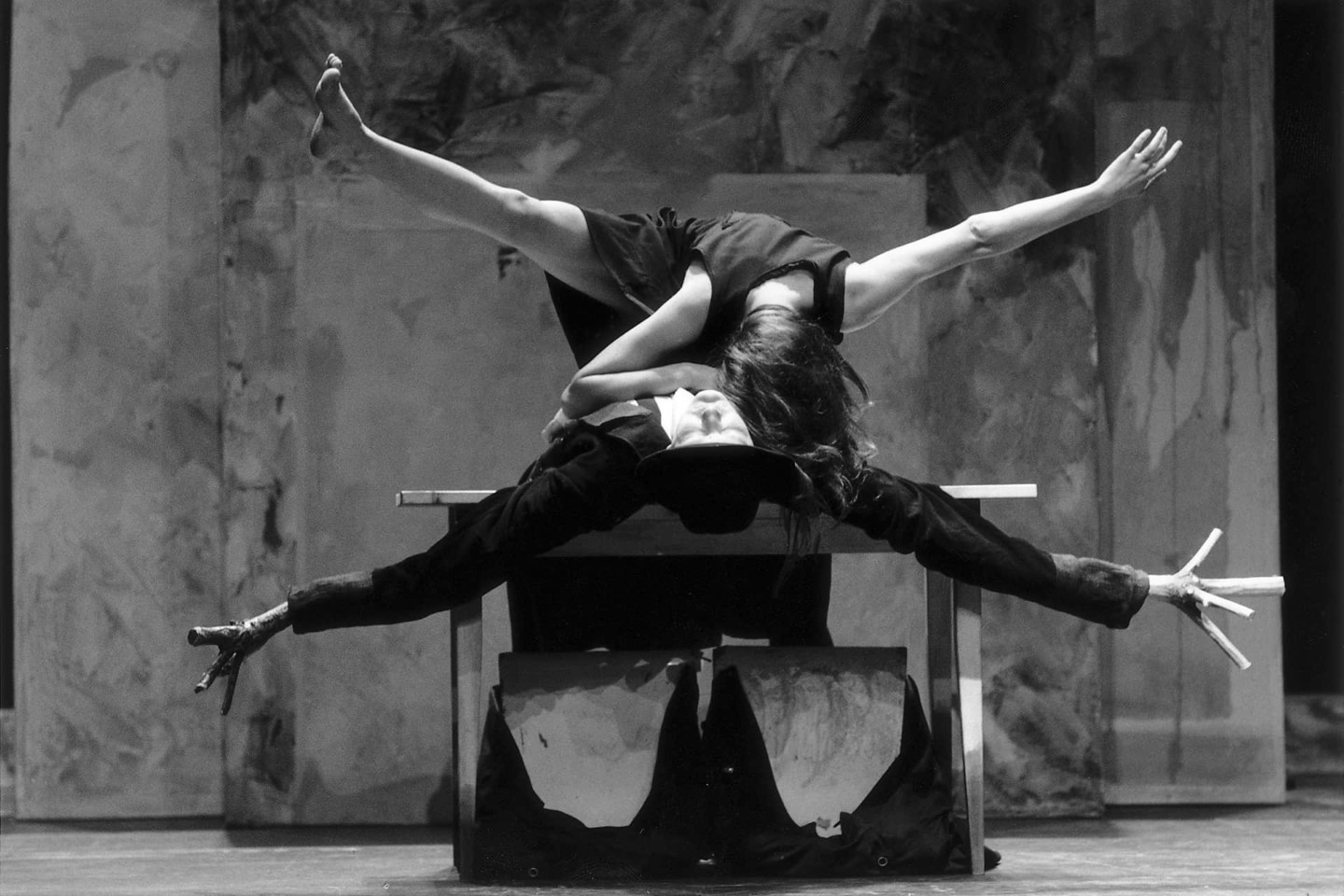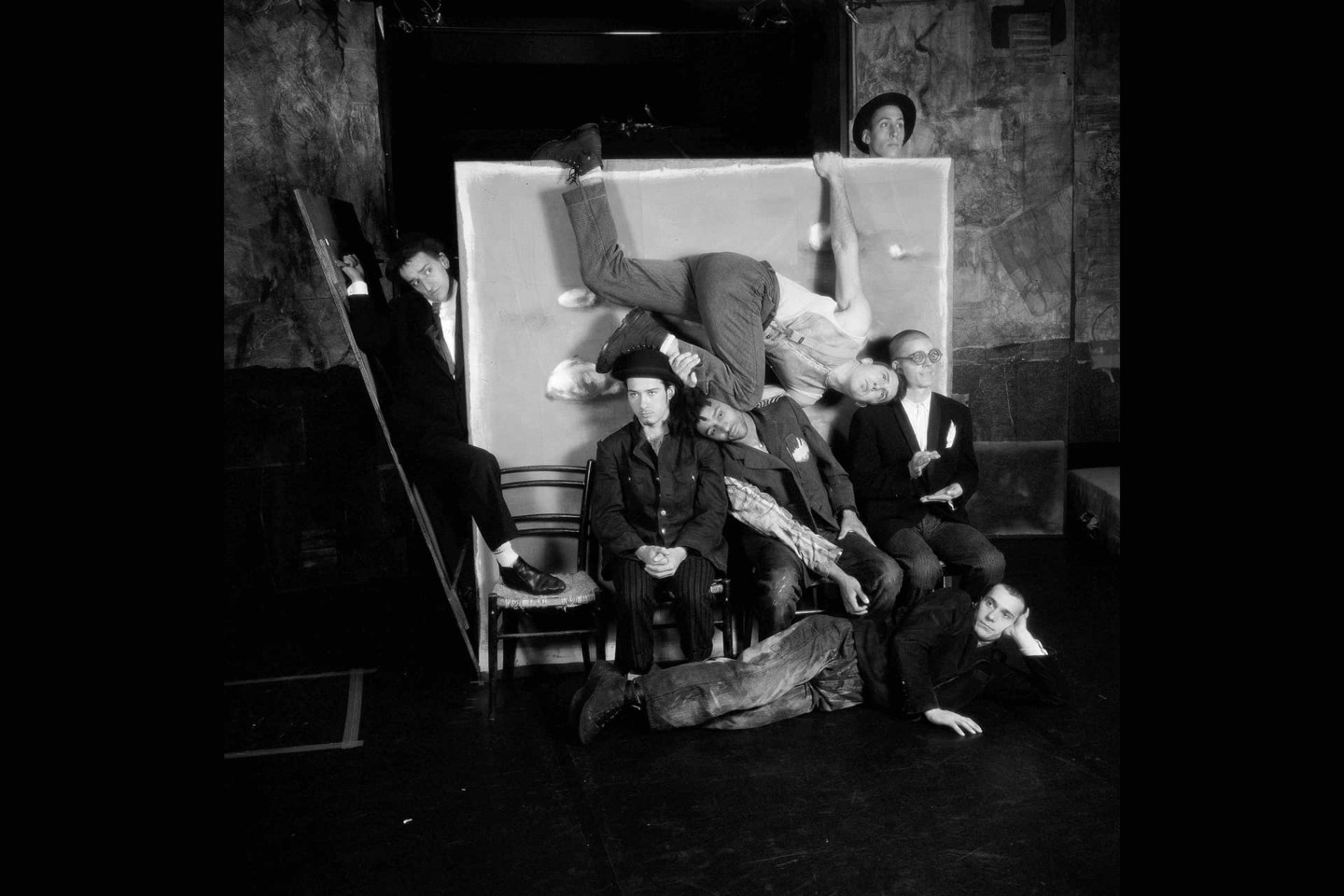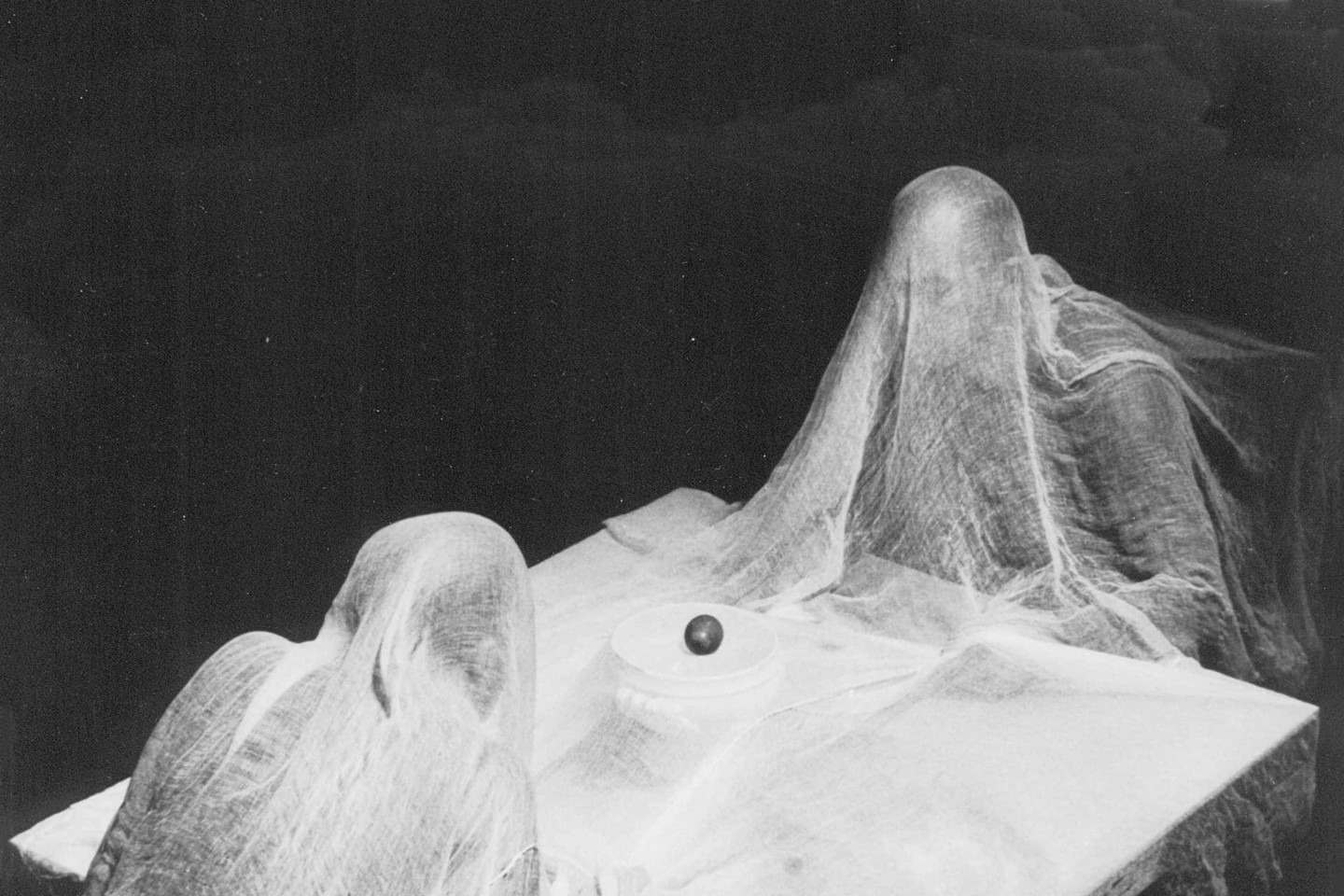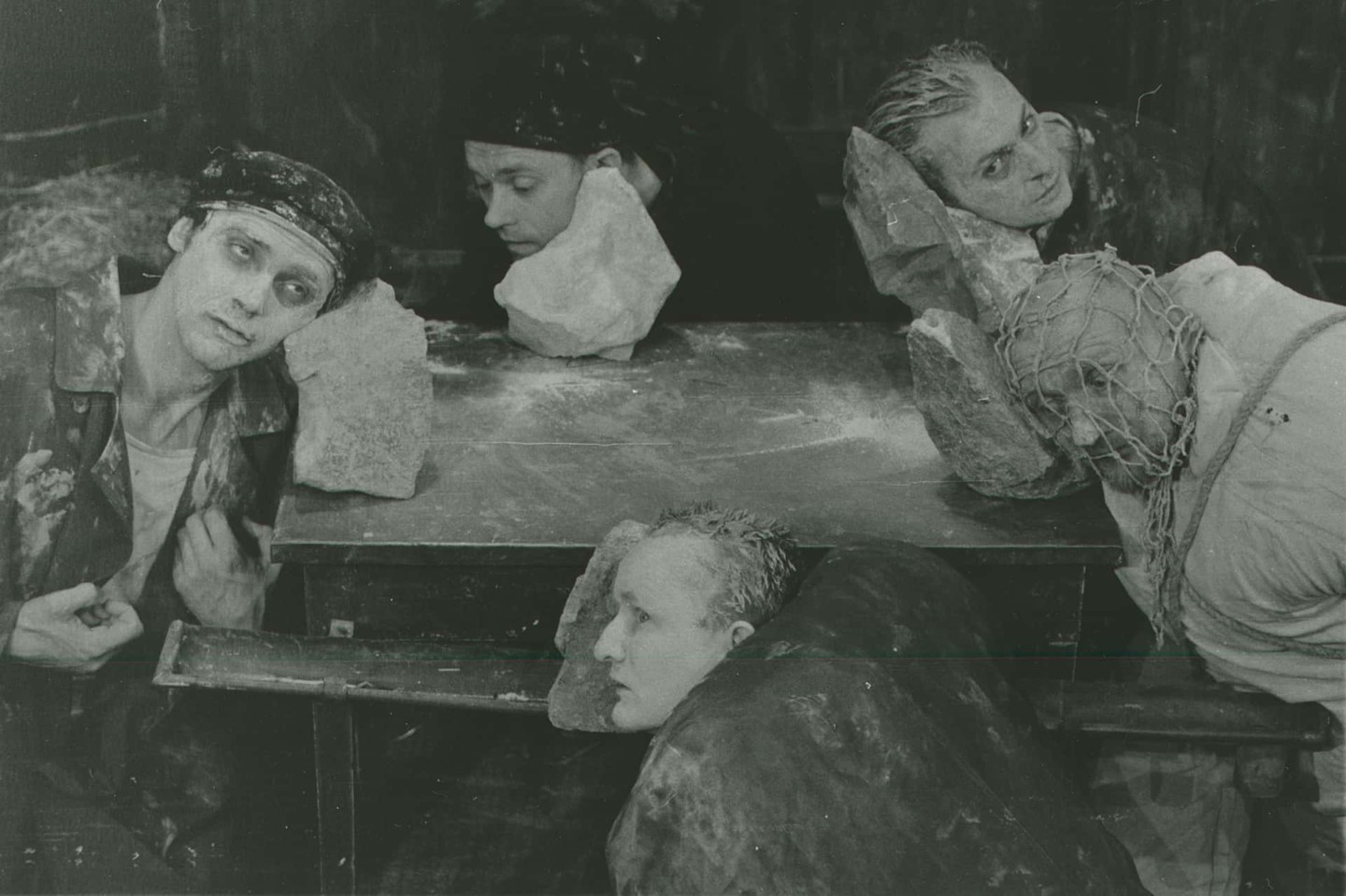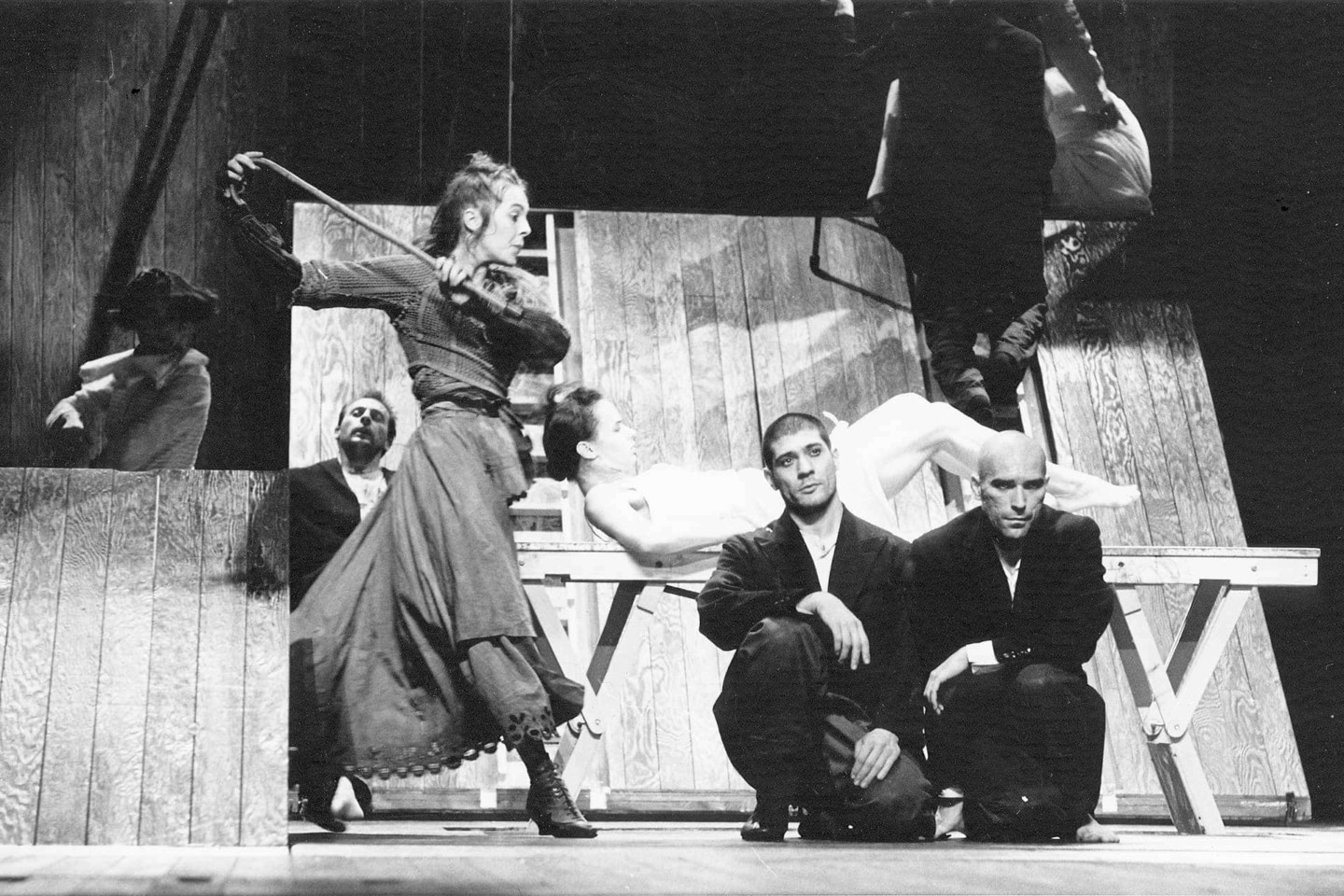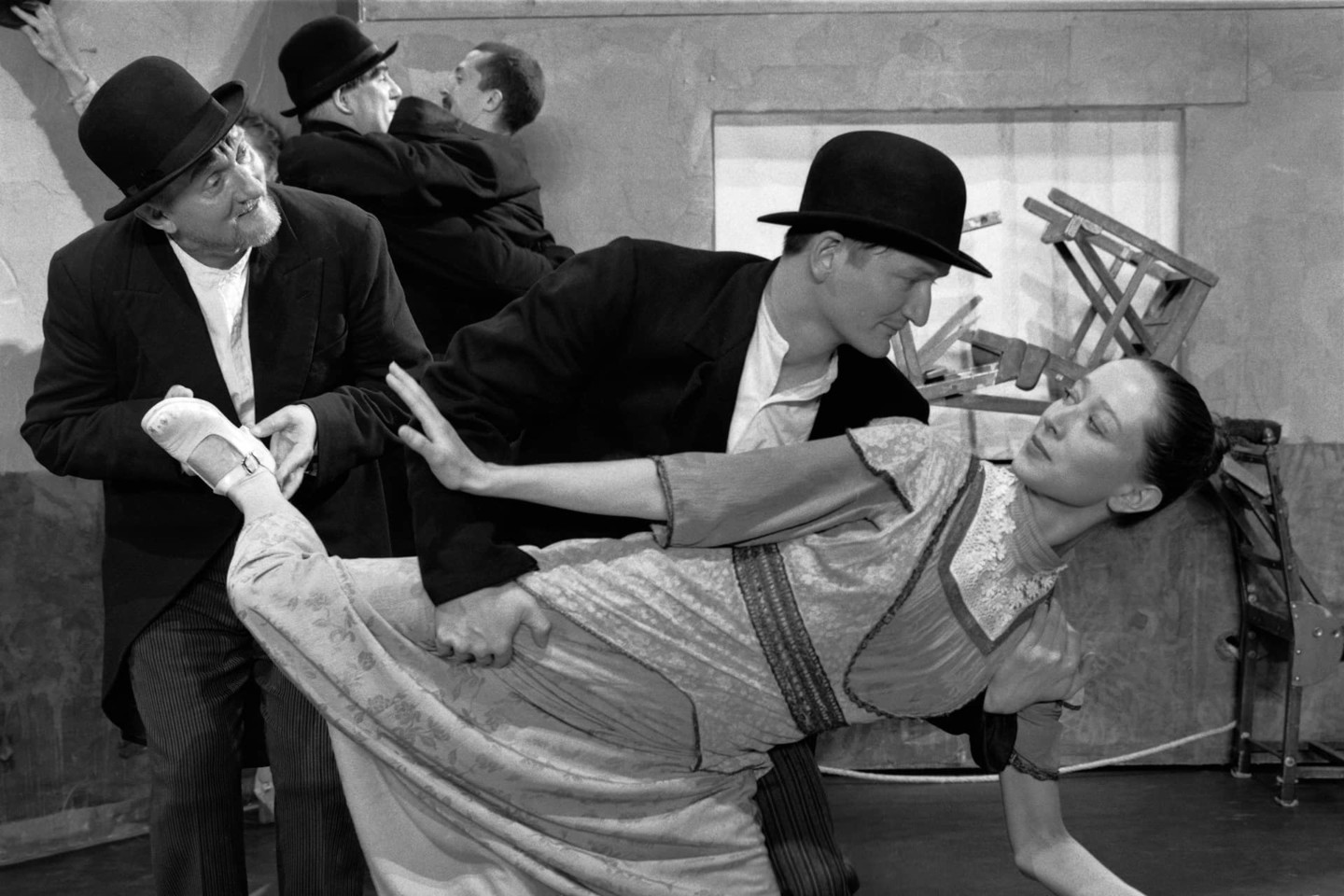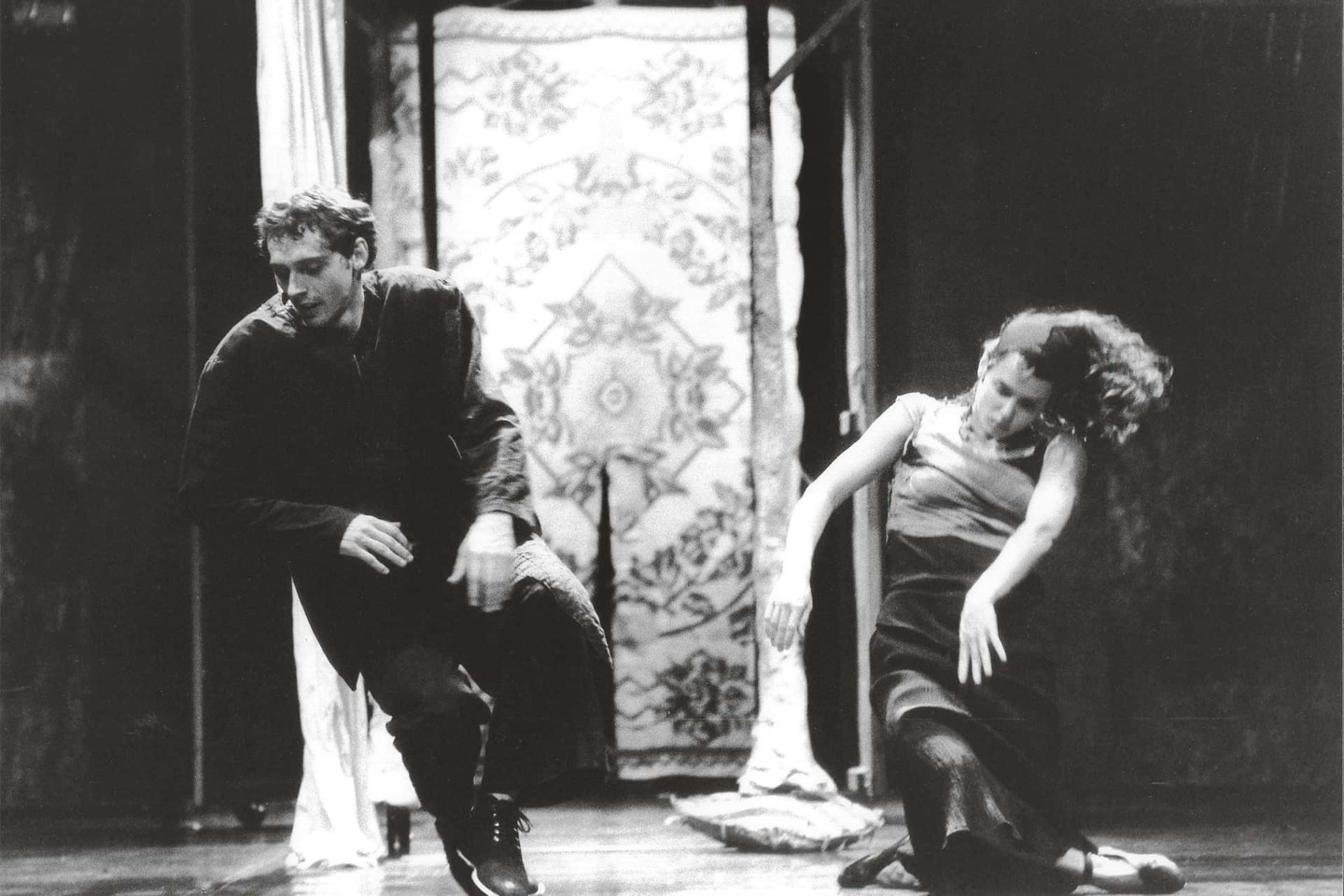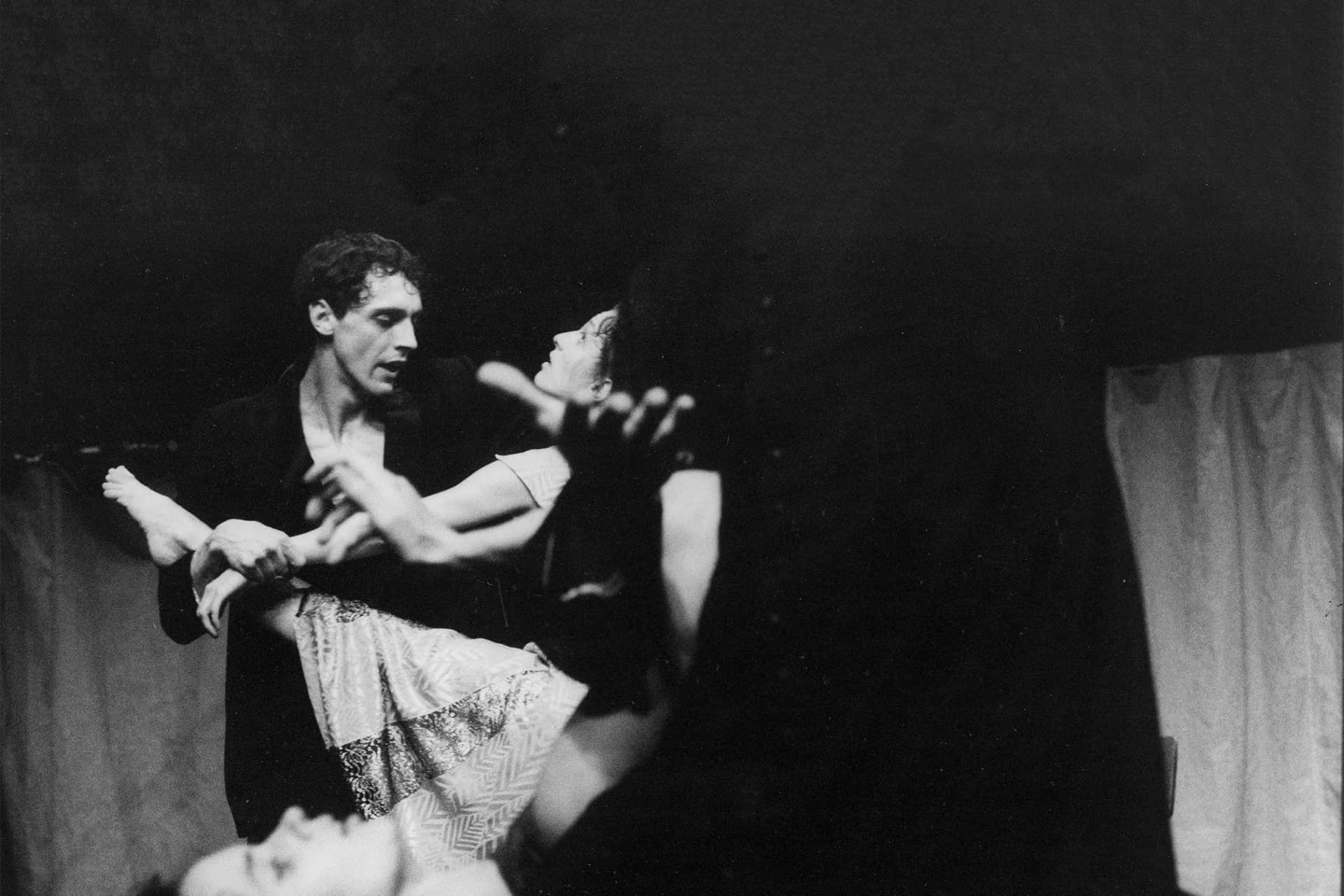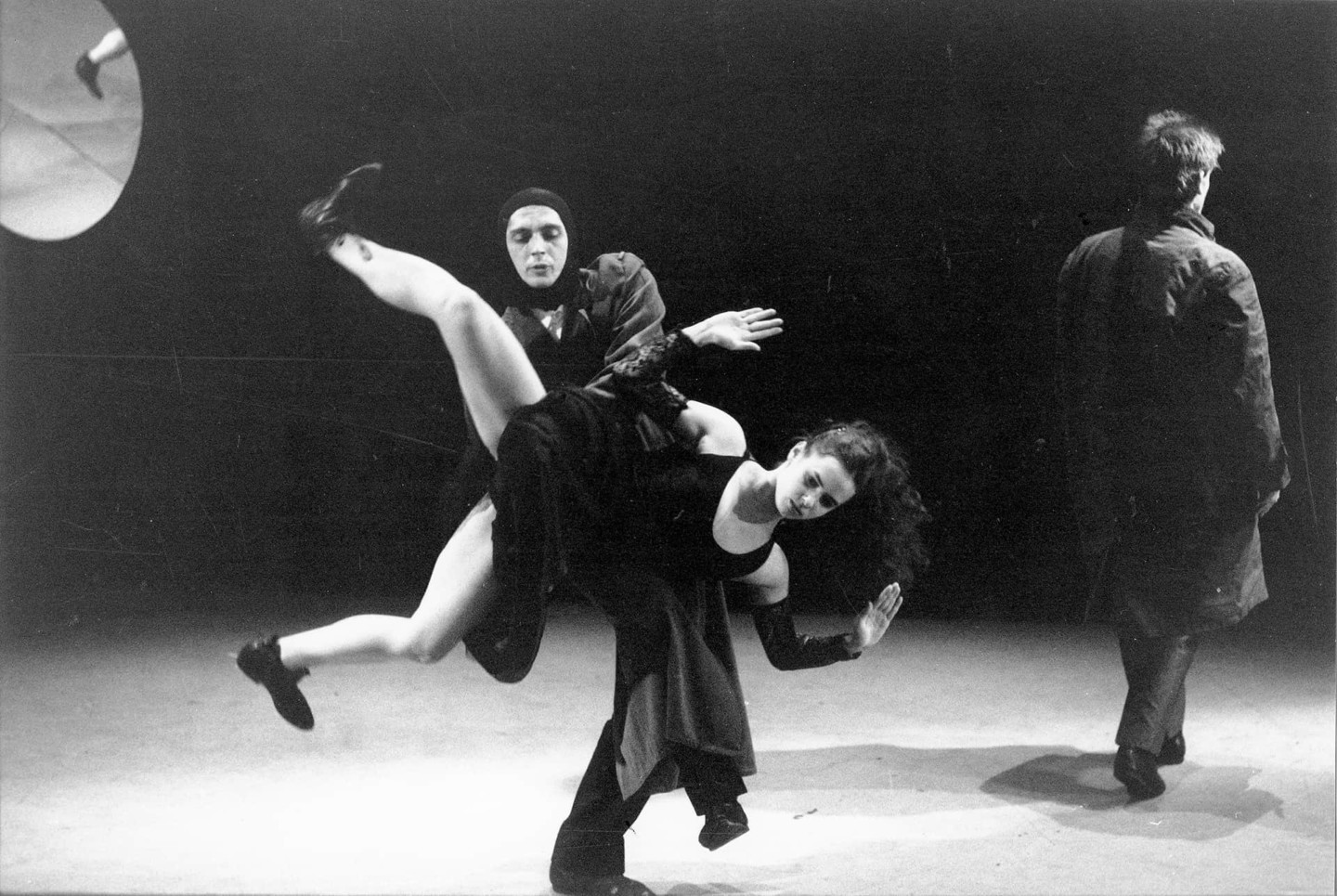Les Commentaires d’Habacuc
Habacuc’s commentaries
A piece by Josef Nadj for 10 performers in tribute to Jorge Luis Borges
Choregraphy
Josef Nadj
Performers
Denes Debrei, Peter Gemza, Mathilde Lapostolle, Nasser Martin-Gousset, Ivan Mathis, Frank Micheletti, Josef Nadj, Cynthia Phung-Ngoc, Gyork Szakony, Valéri Volf
Music
Stevan Kovac Tickmayer
Lights
Rémi Nicolas
assisted by Raymond Blot
Scenography
Goury
assisted by Jacqueline Bosson
Costumes
Suzanne Rippe
Technical director
Raymond Blot
Set construction
Granier Décor, Technical team of the Carré Saint-Vincent – Orléans
Coproduction
Centre chorégraphique national d’Orléans, Theater der Stadt – Remscheid, Hebbel Theater – Berlin
Supports
Carré Saint-Vincent, Scène Nationale d’Orléans, Théâtre de la Ville-Paris
Creation
Gymnase du lycée Aubanel – Festival d’Avignon, 11 july 1996
Prize
1st critic’s Prize “Danza & Danza”, Italy (1996/1997)
The history of the universe — and in it our lives and the most tenuous detail of our lives — is the scripture produced by a subordinate god in order to communicate with a demon.
Jorge Luis Borges
A storyteller must, in addition, place his characters within a defined space. For Jorge Luis Borges, this was the labyrinth, a territory that became for him an obsession. Real or metaphorical, moral or intellectual, it provides a privileged space for a number of tales. In the “awesome” mythology, the labyrinth is a trap where a monster awaits the erring hero at the end of a corridor. One can suppose the labyrinth to be a representation of the world; thus the traces left by human existence can themselves be portrayed as a labyrinth of causes and effects.
My work today is to build, with the help of Jorge Luis Borges’ themes (the nature of time, the infinite, considerations on the origin of human identities) a poetic labyrinth: the object of an “ars combinaria”, which becomes a theatrical performance.
History :
8 février 2003
Fondation Châteauvallon
Ollioules (FR)
14 novembre 2001
Tsukuba Capio
Tsukuba (JP)
9-11 novembre 2001
Setagaya Public Theatre
Tokyo (JP)
23-24 mars 2001
Le Colisée
Roubaix (FR)
4 août 2000
Festival Mimos Odyssée
Périgueux (FR)
13 avril 2000
Le Carreau Scène nationale de Forbach
Forbach (FR)
20-21 août 1999
Internationales Sommertheater
Hambourg (DE)
20 juillet 1999
Festival Danse à Aix-en-Provence
Aix-en-Provence (FR)
11-12 mai 1999
La Comédie de Clermont-Ferrand
Clermont-Ferrand (FR)
10 avril 1999
Théâtre Paul Eluard
Bézons (FR)
30 mars 1999
La Passerelle
Saint-Brieuc (FR)
26 mars 1999
Mediagora
Boulazac (FR)
23 mars 1999
IDDAC
Saint Médard (FR)
13 mars 1999
Espace Malraux
Joué-les-Tours (FR)
23-24 février 1999
Le Phénix
Valenciennes (FR)
20-21 novembre 1998
Association pour la danse contemporaine
Genève (CH)
4-5 juin 1998
Dansens Hus
Stockholm (SE)
29-30 mai 1998
Danseteatre Festspillene i Bergen
Bergen (NOR)
12-16 mai 1998
Théâtre Nationale Populaire
Villeurbanne (FR)
17 février 1998
Le Manège
Reims (FR)
29-31 janvier 1998
Théâtre Garonne
Toulouse (FR)
9-10 janvier 1998
Théâtre de l’Union
Limoges (FR)
18 octobre 1997
Théâtre Acad
Vilnius (LT)
14 octobre 1997
Institut Français d’Ukraine
Odessa (UA)
10 octobre 1997
Centre Culturel Français
Lasi (RO)
7 octobre 1997
Opéra National de Bucarest
Bucarest (RO)
2 octobre 1997
Centre Culturel Français
Ljubljana (SL)
29 septembre 1997
Théâtre national de Szeged
Szeged (HUN)
26 septembre 1997
Institut Français de Hongrie
Budapest (HUN)
4 juillet 1997
Bassbank et Baggerman
Amsterdam (NL)
3-4 juin 1997
Israël Festival
Jerusalem (IS)
30 avril-3 mai 1997
Theaterhaus Gessnerhalle
Zürich (CH)
22 mars 1997
La Ferme du Buisson
Marne-la-Vallée (FR)
4-15 mars 1997
Théâtre de la Ville
Paris (FR)
12-14 février 1997
Hebbel Theater
Berlin (DE)
31 janvier 1997
Espace Malraux
Chambéry (FR)
24-25 janvier 1997
De Singel
Anvers (BE)
7 décembre 1996
Theater Remscheid
Remscheid (DE)
27-29 novembre 1996
Scène nationale d’Orléans
Orléans (FR)
24 juillet 1996
Internationale Tanzwochen/Museumsquartier
Vienne (AT)
19 juillet 1996
Festival Bolzano Danza
Bolzano (IT)
11-16 juillet 1996
Festival d’Avignon
Avignon (FR)
Le Cri du Caméléon
The Chameleon’s cry
End of the year show of the 7th year group of the CNAC – National Center for Circus arts
Choregraphy & direction
Josef Nadj
Assistant
Franck Micheletti
With the 7th year group CNAC’s students
Etienne Arlettaz, Arnaud Clavet, Vincent Gomez, Laurent Letourneur, Michael Mercadié, Bruno Michel, Jambenoix Mollet, Laurent Pareti, Thomas Van Uden, Martin Zimmermann
Music
Stevan Kovac Tickmayer
Lights
Laurent Fachard
Scenography
Goury
Costumes
Sandrine Pelletier
Production
Centre National des Arts du Cirque
Creation
Centre National des Arts du Cirque – Châlons-en-Champagne, december 1995
Prize
Best performance at Festival Mercad de Flores, Barcelona, Spain
What ideas cause Man to explore things which are not natural for him? “Tracking the myth of supermen – Icarus, Heracles, …. – Man replays this singular adventure in front of us, in which he strives to overcome a universe of dreams, hallucinations, memories … The Circus.
Josef Nadj, attracted by the fantastic and absurd universe of Alfred Jarry, creates a poetry of correspondence in which circus, dance and music techniques circulate, a place of physical accomplishments where the unexpected can reveal itself.
The Chameleon’s cry calls forth the idea of the metamorphosis, and the longing to adapt to different spaces. A place where fantastic forces deploy their tricks and surnatural ones their cunning. No identity of any kind is settled upon … which gives Josef Nadj and his team every possible freedom.
Nadj, nouvelle piste pour la danse. Le chorégraphe signe le spectacle annuel de l'école du cirque de Châlons.
Laurent voulait être danseur. Recalé à l'entrée du Centre national de danse contemporaine d'Angers, il se tourne vers le cirque et passe avec succès le concours du Centre national des arts du cirque de Châlons-sur-Marne (CNAC). Il ne pouvait alors prévoir qu'après deux années d'études il décrocherait son diplôme, comme ses neuf camarades de la 7e promotion, à l'issue d'un spectacle signé par une des figures de proue de la chorégraphie contemporaine, Josef Nadj. Il sera donc danseur, voltigeur, clown et musicien à la fois. Cette polyvalence est à l'image de l'évolution et du décloisonnement du monde des circassiens: le Cnac, école nationale supérieure qui vient de fêter ses dix ans, a réussi le pari cher à son directeur, Bernard Turin, de faire émerger une nouvelle génération d'artistes, aujourd'hui très sollicités sur les scènes nationales comme internationales. Citons le Cirque O, Que-Cir-Que, les Nouveaux-Nez, Johann le Guillerm (Cirque Ici), Nikolaus et d'autres artistes que l'on croise dans différentes compagnies: Plume, Baroque, Archaos, Cirque du Soleil, Zingaro, Knie, Gosh...
A peine sortis de l'école, les étudiants de la 7e promo ont monté leur compagnie et démarrent une tournée avec leur spectacle au titre emblématique: le Cri du caméléon. Ils partagent en effet avec le petit reptile l'étrange faculté de se fondre dans l'environnement, en l'occurrence celui que leur a spécialement concocté le chorégraphe. Un univers moribond et inquiétant comme les affectionne Josef Nadj, qui s'est inspiré du roman d'Alfred Jarry, les Surmâles. Au centre de la scène, frontale, prend place une sorte de boîte de Pandore, au décor nuageux évoquant l'univers surréaliste de Magritte, d'où s'échappent en ordre dispersé et de tous côtés de drôles de bonhommes: difformes, grands, petits, l'air hagard avec la boule rasée, en costume noir, le chapeau vissé sur la tête jusqu'au cou, désarticulés, empêtrés dans des souliers trop larges ou coincés dans une caisse à roulettes... Chacun déploie force et ingéniosité afin de se mouvoir et préserver un équilibre sans cesse fragilisé. Pour illustrer l'argument, Nadj cultive l'absurde, et de fait surprend souvent là où on ne l'attend pas. Le judicieux parti-pris mêle imperceptiblement chorégraphie et numéros de jonglage, jeux de mains à mains ou d'équilibres. Le dispositif scénique règle avec légèreté et fluidité les transitions. Josef Nadj s'est visiblement délecté à briser et à corrompre le corps des athlètes, penchant avec allégresse pour le versant freaks du cirque. Corps rigides, élastiques, amorphes, mutilés ou corps marionnettes, le chorégraphe décline, dans une frénésie de mouvements, de lentes métamorphoses et avec une touche d'humour, toute une gamme de postures poussant à son terme les potentialités de chaque interprète. Le spectacle est l'aboutissement de près d'un an de travail. Dès le mois de janvier dernier, le chorégraphe a observé les étudiants, jaugé leur savoir-faire, apprécié leurs envies. Josef Nadj aurait bien substitué aux quilles des jongleurs de nouveaux accessoires afin de faire disparaître toute évocation trop voyante du cirque. Mais un tel changement exige des artistes des mois d'entraînement. Ce mariage hors norme du cirque avec la danse contemporaine ne devrait pas manquer de faire des émules. C'est la première fois que Bernard Turin fait appel à un chorégraphe pour le spectacle de sortie des étudiants. L'absence de texte, loin de constituer un obstacle, comme pour les metteurs en scène de théâtre qui l'ont précédé, a permis à Nadj et aux interprètes de donner toute la mesure de leur virtuosité. Après les cirques traditionnels, puis les nouveaux cirques, il faut désormais compter avec le cirque contemporain.
Marc Laumonier - Libération - 15 janvier 1996
Eclairage
Initialement, le pôle de formation du Centre National des Arts du Cirque, l'Ecole Supérieure des Arts du Cirque (ESAC), ouvert en 1985, dispense une formation en quatre ans. Depuis 1991, elle s'articule en deux cursus. Le premier, dispensé à l'Ecole Nationale des Arts du Cirque de Rosny-sous-Bois (ENACR), dirigée par Anny Goyer depuis 1994, conduit au Brevet Artistique des Techniques du Cirque ; le second à l'Ecole Supérieure des Arts du Cirque de Châlons-en-Champagne prépare au Diplôme des Métiers des Arts du Cirque (DMAC).
Les seize étudiants par promotion accueillis à l'ESAC reçoivent un enseignement théorique et pratique pluridisciplinaire réparti sur deux ans. A l'équipe d'enseignants titulaires sont associés des intervenants extérieurs et des artistes invités.
Engagés dans un processus de création individuel, puisque les élèves travaillent autour de leur spécialité des numéros autonomes, ils le sont également collectivement dans le cadre du spectacle de fin d'études, instauré dès 1989, année de sortie de la première promotion. Si la prise de fonction de Bernard Turin a été déterminante pour le développement de l'école, elle l'est aussi pour son rayonnement en relation avec cette initiative. En effet, il confie sa réalisation à des artistes metteurs en scène ou chorégraphes reconnus professionnellement, afin que les étudiants porteurs de leur propre projet soient investis dans une entité cohérente. Ces réalisations acquièrent une notoriété certaine depuis que Josef Nadj, en 1995, conçoit celui de la 7ème promotion, Le Cri du caméléon, qui de par la force de proposition du chorégraphe et l'efficacité de la rencontre avec le groupe [1] confèrent un statut d'œuvre à un spectacle d'école de cirque. Josef Nadj, après une période de formation et d'échange avec les élèves, estime devoir avancer sur deux fronts : « Je connaissais dès le départ le compromis que j'allais devoir gérer : il fallait utiliser tous leurs numéros – car c'est un spectacle de diplôme de fin d'études, c'était la figure imposée – et en même temps, il fallait que j'essaie de les ouvrir, de leur injecter de nouvelles matières » [2]. Ce spectacle s'inspire de l'univers fantastique et absurde d'Alfred Jarry, tout particulièrement de son roman Le Surmâle. Comme dans nombre des chorégraphies de Josef Nadj l'espace scénique, frontal, est chargé d'objets. Si le corps des danseurs explore l'intervalle, en se glissant dans les interstices, celui des artistes de cirque se confrontent à l'objet, y prennent leurs appuis pour un nouvel élan. Ainsi, immergées dans un nouvel environnement, les techniques de cirque sont chahutées, détournées, et affirment leur droit à la parole. Le cirque fait une nouvelle fois la preuve qu'il peut sortir de l'univers du divertissement et accéder au statut d'œuvre. Cette réalité présente dans les spectacles des compagnies fondatrices du genre Archaos, Plume ou Baroque prend une dimension toute particulière lorsqu'elle est réalisée par les élèves de l'école nationale dont s'est dotée l'Etat qui prouve ainsi la pertinence de son engagement. De plus, programmé à la Grande Halle de la Villette, Le Cri du caméléon reçoit l'ovation de la presse.
Les spectacles du CNAC conservent ce rendez-vous annuel, pour lequel ils sont attendus comme un des événements majeurs qui rythme la vie du cirque en France. Le Cri du caméléon appartient dorénavant au patrimoine culturel du nouveau cirque ; il est devenu emblématique.
[1] Les élèves de cette promotion (rejoints par le fascinant trampolineur Mathurin Bolze, de la promotion suivante) se constituent d'emblée en une compagnie qui prend pour nom Anomalie. Celle-ci crée, collectivement, en 1998, 33 tours de piste, un «concert lyrique», sorte de cabaret dans lequel alternent des exhibitions de danse et de cirque.
[2] Josef Nadj, « Josef Nadj », propos recueillis par Marc Moreigne, dans Le Cirque contemporain, la piste et la scène, Op. cit. p. 129.
Martine Maleval
History :
12-20 janvier 1996
Grande Halle de la Villette
Paris (FR)
7-17 décembre 1995
Centre National des Arts du Cirque
Châlons-en-Champagne (FR)
L'Anatomie du fauve
A piece by Josef Nadj based on the works of Oskar Vojnić
Choregraphy
Josef Nadj
Performers
Istvan Bicskei, Denes Dobrei, Peter Gemza, Franck Micheletti, Josef Nadj, Jozsef Sarvari, Gyork Szakonyi
Music
Stevan Kovac Tickmayer
Performed by
Stevan Kovac Tickmayer – piano
Chris Cutler – percussions
Scenography
Goury
Lights
Rémi Nicolas
assisted by Raymond Blot
Set construction
Le Vif, Fred Jack & Philippe Richard
Production
Théâtre JEL
Coproduction
Centre de production chorégraphique d’Orleans, Théâtre National de Bretagne – Rennes, Théâtre de la Ville – Paris, La Coursive Scène Nationale – La Rochelle, Carré Saint-Vincent – Scène National d’Orléans
Thanks to
Carré Saint-Vincent – Scène Nationale d’Orléans, Théâtre National de Bretagne
Creation
Scène nationale d’Orléans – november 1994
This performance pays homage to travel-writer Oskar Vojnić. Born in 1864 in Hungary, Vojnić died in 1914 in Port-Saïd in Egypt after having spent the last twenty years of his life roaming the globe (Middle-East, Africa, Asia) , spurred by his longing for travel.
Vojnić’s travel bug started with a passion for volcanic landscapes and the diverse manifestations of the earth’s forces. Later on, with a character drawn to adventure, he discovered big cat hunting parties in Africa and started studying the foreign languages he encountered on his travels.
In parallel to his observations on the natural world and big cats, he started questioning himself on the origin of the deeply buried forces which compel men to conquer faraway places, and on the root of Man’s primordial instincts.
As his explorations progressed, he abandoned his research on natural phenomena and animals to focus on a question which was already that of Plato: “What’s in there then, deep down inside myself ?” In the West, Europe was descending slowly into self-destruction and the first signs of a coming war were being witnessed. Vojnić preferred to remain abroad, and put an end to his journey. On the day of his fiftieth birthday, he committed suicide.
His observations and his destiny have become the basis of an interrogation, which remains ours today: how can we preserve the path that man laboriously creates for himself, when history’s path blurs, founders? How can man go forward while constantly achieving a blend between what he is, what he possesses, and the unknown, the foreign? How can that moment be found again, deep inside all men, when Man’s primordial instinct rubbed shoulders with animals’ original instincts?
Josef Nadj – october 1994
History :
7-8 décembre 2000
Scène nationale d’Orléans
Orléans (FR)
26-27 avril 1996
Springdance Festival Stadschouwbourg
Utrecht (NL)
13-14 avril 1996
Altenburg Gerta Theater
Gera (DE)
23 janvier 1996
Théâtre Onyx
Nantes (FR)
15 décembre 1995
Maison des Congrès et de la Culture
Clermont-Ferrand (FR)
7 novembre 1995
Centre Culturel la Rive Gauche
Saint-Étienne-de-Rouvray (FR)
9 septembre 1995
Oriente-Occident
Rovereto (IT)
5 juin 1995
Institut Français
Bratislava (SK)
28 mai 1995
Centre Culturel Français
Ljubjlana (SI)
23 mai 1995
Centre Culturel Français
Nova Gorica (SI)
20 mai 1995
Institut Français
Budapest (HUN)
13 mai 1995
La Filature
Mulhouse (FR)
5 mai 1995
La Ferme du Buisson
Noisiel (FR)
31 mars 1995
Théâtre Toursky
Marseille (FR)
21-22 mars 1995
Théâtre Garonne
Toulouse (FR)
10 mars 1995
Espace Olivier Carol, Scène nationale de Foix
Foix (FR)
7 mars 1995
La Passerelle
Saint-Brieuc (FR)
15 février 1995
La Coursive Scène nationale de La Rochelle
La Rochelle (FR)
20 janvier 1995
TNDI
Ollioules (FR)
12-14 janvier 1995
Théâtre de Singel
Anvers (BE)
14-22 décembre 1994
Théâtre de la Ville
Paris (FR)
novembre 1994
Scène nationale d’Orléans
Orléans (FR)
Woyzeck ou l'ébauche du vertige
Woyzeck or the hint of vertigo
Free adaptation of Woyzeck de Georg Büchner
Choregraphy
Josef Nadj
Performers (creation)
Guillaume Bertrand, Istvan Bickei, Denes Debrei, Samuel Dutertre or Franck Micheletti, Peter Gemza, Josef Nadj, Henrieta Varga
Performers (new versions)
István Bicskei, Dénes Döbrei, Gyula Francia, Péter Gemza, János Mercs, Josef Nadj, Henrietta Varga
Music
Aladar Racz
Lights & technical direction
Raymond Blot
Coproduction
Théâtre National de Bretagne – Rennes, Centre chorégraphique national d’Orléans
Creation
Théâtre National de Bretagne – Rennes, march 1994
Duration
60 min
Prize
Audience’s prize at 32e BITEF Festival in 1998 ; “Golden Mask” for best foreign performance Masque d’or » in Russia in 2002
Alone among Josef Nadj’s works, Woyzeck ou l’Ébauche du vertige [Woyzeck or The hint of vertigo] is explicitly based on a dramatic text. Nevertheless, that text is a work under construction, or as Jean-Christophe Bailly wrote, “a form in evolution, stopped dead by the death of the author”. The manuscript Georg Büchner left behind is in fact composed of four distinct versions, four “rough drafts”, each more or less long, complete, consistent, detailed and super-imposable.
Rather than isolate one version, rather than arbitrarily extract a single linear account from these scattered fragments, Nadj cultivated their unfinishedness – and the repetitive character they give off. He hollowed out the text, disunited it even further, bringing out the author’s “voice” and his obsessive questioning of human nature and the inexorable march of destiny. Moreover Nadj has drawn a connection between Büchner’s precocious death and the madness that inhabited him at the end of his life with two key components of the drama: the crime of passion committed by the character Woyzeck, and the unbearable pressure exerted upon him – a process of dehumanisation leading him to madness and murder. In Nadj’s Woyzeck, tragedy has really taken place.
In a possible echo of the fratricidal war that tore Yugoslavia apart at the time of the piece’s creation (1993-1997), Nadj’s reading offers a vision of decomposition gradually gaining the bodies and minds.
Woyzeck ou l’Ébauche du vertige is crude, trivial, organic, a piece that has been skinned alive, where nevertheless a climate of burlesque reigns. Confined in a restrained space, misshapen beings, almost human in appearance, abandon themselves to their cruel play against a background of festive music.
Myriam Bloedé, translated into English by David Vaughn
This truth, first of all - known and recognised, but always forgotten : that Woyzeck is an unfinished tragedy, the state of a constantly evolving shape that the author’s death brought to an abrupt halt. Not a play in fragments, but a play in pieces : for the whole of pieces is not that of fragments, it is less noble, it has not lain in science and does not form itself into a network but piles itself up in a simple way, one stratum after another. Pieces displayed, piled up on the stage, here and there...
The voices talking in Woyzeck talk amidst the insanity that the law should not (or no longer) exist and that, for the poor, the place of the law should be taken by nature, but like an empty space : bottles drunk in cabarets, animals gleams in the night. Since it is written before « the poor » form themselves (or are formed) into revolutionary subjects - thus before they gather around a law or whatever can take the place of the law - the story of Woyzeck and Marie, although it is situated from a historical point of view, and even situation in the rat-hole of low sky Vormäz, in Germany, is beyond any heroic agitation, and beyond any biased or edifying recitation.
Jean-Christophe Bailly
History :
27 mars 2018
THÉÂTRE THÁLIA
Košice (SK)
25 février 2018
Théâtre Csokonai
Debrecen (HG)
7-9 juin 2014
International Platonov Festival
Voronezh (RU)
21-23 février 2014
National Chiang Kai-Shek Cultural Center
Taipei (TWN)
12 octobre 2013
ATER
Prato (IT)
8-9 octobre 2013
Centre Culturel André Malraux
Vandœur-les-Nancy (FR)
21 juillet 2013
Festival d’Avignon, Opéra Grand Avignon
Avignon (FR)
19 octobre 2012
Maison des Arts Thonon – Evian Théâtre Novarina
Thonon-les-Bains (FR)
15 octobre 2011
Festival PerformDance
Venise (IT)
11-12 octobre 2011
Festival PerformDance
Alessano (IT)
11 janvier 2011
Théâtre de la Madeleine
Troyes (FR)
7 décembre 2010
Hungarian Theatre of Cluj
Cluj (ROM)
26 novembre 2010
Les théâtres de la ville de Luxembourg
Luxembourg (LUX)
20 octobre 2010
Centre Culturel Jean Gagnat
Limoges (FR)
22 avril 2010
La pléade
La Riche (FR)
13 mars 2010
L’Avant Scène
Cognac (FR)
10 mars 2010
Théâtre d’Aurilac
Aurilac (FR)
5 février 2010
Espace 1789
Saint-Ouen (FR)
18-19 juillet 2009
Corso Film Theater
Ludwigshafen (DE)
7-8 novembre 2009
Teatro Linea de Sombra
Mexico (MEX)
18-19 juillet 2009
International Kalamata Dance Festival
Kalamata (GR)
26-29 novembre 2008
Scène Nationale d’Orléans
Orléans (FR)
6-7 novembre 2008
Festival EuroScene
Leipzig (DE)
22-23 avril 2008
L’Hippodrome Scène Nationale de Douai
Douai (FR)
29-30 novembre 2007
Théâtre en Dracénies
Grasse (FR)
20 novembre 2007
Théâtre du gymnase
Marseille (FR)
16 novembre 2007
Forum Meyrin
Génève (CH)
25 mai 2007
Circuits Scène conventionnée Centre Cuzin
Auch (FR)
22 mai 2007
Théâtre du Beauvaisis
Beauvais (FR)
20-21 septembre 2006
Csokonai Théâtre
Debrecen (HUN)
4-5 mai 2006
Théâtre de Cavaillon
Cavaillon (FR)
10 mars 2006
Théâtre d’Albi
Albi (FR)
16-17 juin 2005
Kuopio Dance Festival
Kuopio (FI)
10-11 mai 2005
Teatro Canovas
Malaga (ES)
7-8 mai 2005
Teatro Tamajo
Grenade (ES)
30 mars – 1er avril 2005
Comédie de Clermont-Ferrand
Clermont-Ferrand (FR)
20 janvier 2005
Théâtre de Vanves
Vanves (FR)
8-9 juin 2004
Festival Modern Dance Theatre – Théâtre Comhouria
Le Caire (EGY)
6 avril 2004
Théâtre Mac-Nab
Vierzon (FR)
12 mars 2004
CDN de Normandie Comédie de Caen
Caen (FR)
13 février 2004
Oloron-Sainte-Marie (FR)
11 février 2004
Théâtre de Feu
Mont-de-Marsan (FR)
6 février 2004
Théâtre de Cahors
Cahors (FR)
24 janvier 2004
Théâtre d’Evora
Evora (PT)
20-21 janvier 2004
CC de Belem
Lisbonne (PT)/span>
16-17 janvier 2004
Théâtre de Viriato
Viseu (PT)/span>
4 décembre 2003
La ferme de Bel Ebat
Guyancourt (PT)
2 décembre 2003
Centre Culturel Aragon Triolet
Orly (FR)
24 novembre 2003
Théâtre Firmin Gémier
Antony (FR)
22 novembre 2003
Théâtre de Châtillon
Châtillon (FR)
20 novembre 2003
Arc-en-Ciel Théâtre de Rungis
Rungis (FR)
18 novembre 2003
La Rotonde Scène Nationale de Sénart
Sénart (FR)
4 février 2003
Théâtre de Chartres
Chartres (FR)
22-23 novembre 2002
Centre Culturel Français de Moscou
Moscou (RU)
13 novembre 2002
Centre Culturel Français de Saint-Petersbourg
Saint-Petersbourg (RU)
20-21 septembre 2002
Théâtre Municipal de Bruges
Bruges (BE)
30 avril 2002
Teatro Juan de la Encina
Salamanca (ES)
28 avril 2002
Teatro Juan Bravo
Segovia (ES)
27 avril 2002
Teatro Principal
Burgos (ES)
26 avril 2002
Palacio de la Audencia
Soria (ES)
24 avril 2002
Teatro Gayarre
Pamplona (ES)
23 avril 2002
Teatro Principal
Vitoria (ES)
21 avril 2002
Auditorio Angel Barja
Leon (ES)
20 avril 2002
Teatro Ambigu
Valladolid (ES)
12 mars 2002
Le Cadran
Briançon (FR)
8-9 mars 2002
Atelier du Rhin
Colmar (FR)
14 février 2002
Teatro Bonci
Cesena (IT)
12 février 2002
Teatro Gustavo da Modena
Genova (IT)
8-10 février 2002
Teatro Delle Passioni
Modena (IT)
6 février 2002
Teatro Zanon
Udine (IT)
22-23 janvier 2002
Théâtre Jean Vilar
Vitry-sur-Seine (FR)
31 mai et 1er juin 2001
CNCDC
Châteauvallon (FR)
17 mai 2001
Mais du Théâtre et de la Danse
Épinay-sur-Seine (FR)
13 avril 2001
Le Vivat d’Armentières
Armentières (FR)
3 mars 2001
Vandœuvre (FR)
31 janvier et 1er février 2001
Deutsches Nationaltheater E-Werk
Weimar (DE)
8 novembre 2000
Théâtre dramatique russe de Lituanie
Vilnius (LT)
5 novembre 2000
Nouveau Théâtre de Riga
Riga (LVA)
1er novembre 2000
Centre culturel français de Tallinn
Tallinn (EST)
1er novembre 2000
Centre culturel français de Tallinn
Tallinn (EST)
5-7 septembre 2000
Séoul Theatre Festival Munye Theatre
Séoul (KOR)
18-19 juillet 2000
Freiburger Theaterfestival E-Werk
Freiburg (DE)
3 juin 2000
Théâtre
Remscheid (DE)
16 avril 2000
Posthof
Linz (AUT)
23-25 mars 2000
Le Maillon
Strasbourg (FR)
10 mars 2000
Théâtre Municipal La Saint Gaudingue
Saint-Gaudens (FR)
9 mars 2000
Scène Nationale de Foix
Foix (FR)
16-17 février
Osaka (JP)
9-13 février 2000
Setagaya Public Theatre
Tokyp (JP)
18-29 janvier 2000
Théâtre de la Bastille
Paris (FR)
4 décembre 1999
La Fabrique
Meung-sur-Loire (FR)
31 mai et 1er juin 1999
Scène Nationale d’Orléans
Orléans (FR)
23-24 avril 1999
Théâtre de l’Espace
Besançon (FR)
27-30 janvier 1999
Hong Kong Arts Festival
Hong-Kong (CHN)
19-22 janvier 1999
Sydney Festival
Sydney (AUS)
9-12 janvier 1999
Mime Festival
Londres (UK)
15-19 décembre 1998
Théâtre Garonne
Toulouse (FR)
16 octobre 1998
Les Rencontres d’Octobre
Liège (BE)
25-27 septembre 1998
Festival International de Théâtre Bitef Teatar
Belgrade (SRB)
22-26 août 1998
Festival Internactional de Teatro
Belo Horizont (BR)
17-19 juillet 1998
Internationale Tanz Wochen
Vienne (AUT)
12-14 juin 1998
Siges Teatre Internacional Teatro Mercat
Sitges (ES)
4-6 avril 1998
Festival Iberoamericano de Teatro de Bogota
Bogota (COL)
4-7 février 1998
La Filature
Mulhouse (FR)
23 octobre 1997
International Theatre Festival
Sarajevo (BIH)
13-21 juillet 1997
Chapelle des Pénitents Blancs Festival d’Avignon
Avignon (FR)
5-6 juillet 1997
Van Baasbank & Baggerman
Amsterdam (NL)
5-6 juin 1997
Israël Festival
Jerusalem (IL)
9-10 mai 1997
Mousonturm
Francfort (DE)
28 mars 1997
Théâtre Municipal de Privas
Privas (FR)
25-26 mars 1997
Théâtre de la Croix Rousse
Lyon (FR)
15-16 février 1997
Berliner Festspiele
Berlin (DE)
21-22 janvier 1997
De Singel
Anvers (BE)
17-18 janvier 1997
Institut français de Vienne
Vienne (AUT)
14 janvier 1997
Centre culturel Jean Gagnant
Limoges (FR)
7-10 novembre 1996
Festivales de Madrid
Madrid (ES)
18-19 juin 1996
Théâtre Archa
Prague (CZ)
2 mars 1996
Tulles (FR)
27-28 février 1996
New Moves
Glasgow (UK)
26-29 janvier 1996
Teatri di Vita
Bologne (IT)
3 juin 1995
Institut Français de Bratislava
Bratislava (SK)
26 mai 1995
Centre Culturel Français de Ljubljana
Ljubljana (SI)
17-18 mai 1995
Centre Culturel Français de Hongrie
Budapest (HUN)
mars 1994
Théâtre National de Bretagne
Rennes (FR)
Les échelles d’Orphée
A piece by Josef Nadj based on the collection of poems Songs of Wilhem by Otto Tolnaï
Choregraphy
Josef Nadj
Performers
Istvàn Bicskei, Denes Dobrei, Laszlo Hudi, Josef Nadj, Gianfranco Poddighe, Jozsef Sarvari, Gvork Szakonvi, Kathleen Reynolds, Cécile Thieblemont, Léa Tolnaï
Music
Stevan Kovac Tickmayer
Performed by
Laura Levaï-Aksin/Flûte, Branislav Aksin/Trombone, Sasa Dragovic/Trompette, Stéphane Gautier/Basson, Stevan Kovac Tickmayer/Claviers et basse, Nikola Srdic/Clarinette, Milan Vrsajkov/Violoncelle
Lights
Rémi Nicolas
assisted by Victor Corolleur
Scenography
Goury
assisted by Michel Tardif
Costumes
Catherine Rigault
assisted by Frédérique Guillard
Technical director
Jean-Guy Porché
Set manager
Daniel Larue
Stage manager
Michel Tardif
Lights operator
Gérard Hallot
Sound operator
Hervé Stauch, Christophe Quétard
Machinists
Frédéric Assailly, Alain Larue, Michel Martel, Rodolphe Noret
Dresser
Nicole Larue
Accessories
Jean-Claude André
Production
Théâtre JEL
Coproduction
Centre de Production Chorégraphique d’Orléans, Théâtre de la Ville -Paris, Festival d’Avignon, Maison de la Culture – Chambéry, CAC – Annecy, La Coursive’ – La Rochelle, Les Gémeaux – Sceaux, L’Espace des Arts – Chalon sur Saône, L’Hippodrome – Douai, Conseil Général des Hauts de Seine
Creation
Carré Saint-Vincent – Orléans, june 1992
Duration
1h20
History :
20 janvier 1994
L’Arsenal
Metz (FR)
9 décembre 1993
Maison de la Culture et de la Communication
Saint-Etienne (FR)
16 novembre 1993
Art Danse Bourgogne
Châlons-sur-Saône (FR)
12 juin 1993
La Filature
Mulhouse (FR)
20 février 1993
Fondation Châteauvallon
Ollioules (FR)
18 février 1993
Le Théâtre Le Bel Image
Valence (FR)
12 févier 1993
Scène nationale Bonlieu
Annecy (FR)
29 novembre-12 décembre 1992
Théâtre de la Ville
Paris (FR)
6 octobre 1992
Les Gémeaux
Sceaux (FR)
5-6 septembre 1992
Fondation Galouste Gulbenkian
Lisbonne (PT)
15-17 juillet 1992
Théâtre municipal Festival d’Avignon (annulé pour grève)
Avignon (FR)
9-11 juillet 1992
Stadsschouwburg
Amsterdam (NL)
23-24 juin 1992
Theaterhaus Krems
Vienne (AT)
juin 1992
Carré Saint-Vincent
Orléans (FR)
Comedia tempio
A piece for 10 performers in tribute to the life and work of Géza Csáth
Choregraphy
Josef Nadj
Performers
Guillaume Bertrand, Istvan Bickei, Denes Debreï, Peter Gemza, Mathilde Lapostolle or Kathleen Reynolds, Nasser Martin-Gousset, Josef Nadj, Laszlo Rokas, Gyork Joseph Szakonyi, Cécile Thiéblemont
Music
Stevan Kovac Tickmayer
Lights
Rémi Nicolas
assisted by Raymond Blot
Scenography
Goury
Costumes
Catherine Rigault
assisted by Sylvie Régnier
Production
Théâtre JEL
Coproduction
Centre Chorégraphique National d’Orléans, Théâtre de la Ville – Paris, Festival d’automne – Paris, Hebbel theater – Berlin, Les Gémeaux Scène Nationale –Sceaux
Support
Alpha-FNAC
Creation
Orléans, november 1990
Duration
1h20
Prize
Critic’s prize at the Mimos Festival in 1995
Created in the early 90’s, Comedia Tempo is an unforgettable performance. Timeless, but with a strong aesthetic stance, it is a key work in Josef Nadj’s career.
To write this play, choreograph Josef Nadj burrowed into the life of Hungarian writer Géza Csáth, an opium-user who died at the age of 32. While the overall atmosphere of the performance is bleak, the situations created by the dancing are often burlesque, without delving too much into the darkness of the narrative. The performers slip into very serious three-piece suits before rushing into pantomimic gestures infused with acrobatics. The set-design, made of hatches, windows, fences, and effects of appearance and disappearance, has an impact on the bodies on stage, which have to adapt, twist or shrink themselves down. Bodies are carried, towed away, as if they had to escape an overbearing destiny. One situation follows the next, as if in a dream in which speech had been banished, but where the condition of the bodies reveal a community’s struggle to live.
N. Yokel
History :
4 mai 2007
Centre culturel Louis Escande Scène nationale de Mâcon
Mâcon (FR)
26 avril 2007
Théâtre de Sartrouville
Sartrouville (FR)
6 mars 2007
Théâtre de Cornouaille
Quimper (FR)
16-17 janvier 2007
Le Manège de Reims
Reims (FR)
12 mai 2006
Maison de la Culture
Bourges (FR)
28-30 avril 2006
Mercat de las Florès
Barcelone (ES)
3 février 2006
Théâtre Toursky
Marseille (FR)
16 décembre 2005
Théâtre de St Quentin en Yvelines
St Quentin en Yvelines (FR)
21-23 octobre 2005
Festival Novel Hall
Taipei (TW)
13-14 mai 2005
Teatro Centro
Seville (ES)
10 mars 2005
L’Esplanade
St Etienne (FR)
3 février 2005
Le Manège
Maubeuge (FR)
29 janvier 2005
Centre Culturel Louis Aragon
Tremblay en France (FR)
2-4 novembre 2004
Teatro de Madrid
Madrid (ES)
26-29 mars 2004
Festival international du théâtre de Bogota
Bogota (CO)
27-28 janvier 2004
Théâtre de Nîmes
Nîmes (FR)
6 décembre 2003
Théâtre Paul Elouard
Bezons (FR)
29 novembre 2003
Maison de la Musique
Nanterre (FR)
27 novembre 2003
Théâtre Romain Rolland
Villejuif (FR)
3 février 2002
ATER
Trento (IT)
18-20 janvier 2002
London International Mime Festival
Londres (UK)
13+14 février 2001
Théâtre de l’Union
Limoges (FR)
26-27 octobre 2000
Bruxelles (BE)
4 mai 2000
Espace des Arts
Chalon-sur-Saône (FR)
16 novembre 1999
Théâtre de Gironde
Saint-Médard (FR)
2-3 juin 1999
Scène nationale d’Orléans
Orléans (FR)
8 octobre 1998
ATER Teatro Reggio
Turin (IT)
21 juillet 1998
Wiener Burgtheater TanzWochen Wien
Wien (AT)
10-11 juillet 1998
Reithalle Internationales Donaufest
Ulm (DE)
2-3 septembre 1995/span>
Karlskaserne Reithalle Ludwigsburger Schlobfestspiele
Ludwigsburg (DE)
7 août 1995
Mimos Festival
Périgueux (FR)
15 mai 1995
Festival Dance 95 Institut Français de Munich
Munich (DE)
6 mai 1994
Scène nationale de Bayonne
Bayonne (FR)
17 décembre 1993
Association pour le développement culturel de Gap et des Hautes-Alpes
Gap (FR)
2 décembre 1993
Maison de la Culture Scène nationale d’Amiens
Amiens (FR)
15-16 octobre 1993
Nouveau Théâtre d’Angers
Angers (FR)
29 novembre 1992
12 décembre 1992 – Théâtre de la Ville
Paris (FR)
18 novembre 1992
Theaterfestival Euro-Scene
Leipzig (DE)
2 novembre 1992
Institut Français de Prague
Prague (CZ)
30 octobre 1992
Institut Français Théâtre national de Bratislava
Bratislava (SK)
27 octobre 1992
Institut Français Operett Szinhazz
Budapest (HU)
17 octobre 1992
Institut Français Théâtre national de Bucarest
Bucarest (RO)
24-25 juillet 1992
Festival Mittelfest
Udine (IT)
21-23 mai 1992
The Israel Festival
Jerusalem (IS)
21 janvier 1992
Le Manège
Maubeuge (FR)
18 janvier 1992
L’Onyx
Nantes (FR)
14 janvier 1992
Scène nationale de Cergy-Pontoise
Cergy-Pontoise (FR)
11 janvier 1992
Scène nationale de Mâcon
Mâcon (FR)
19 décembre 1991
L’Arsenal
Metz (FR)
12-15 décembre 1991
De Singel
Anvers (BE)
6 décembre 1991
L’Hippodrome
Douai (FR)
30 novembre – 2 décembre 1991
Théâtre Garonne
Toulouse (FR)
30 novembre 1991
Scène nationale d’Angoulême
Angoulême (FR)
16 novembre 1991
Le Parvis
Tarbes (FR)
13 novembre 1991
Grand Théâtre de Saint-Etienne
Saint-Etienne (FR)
8 novembre 1991
Le Moulin du Roc
Niort (FR)
17-19 septembre 1991
Hebbel Theater
Berlin (DE)
11 septembre 1991
Festival d’Hannover
Hanovre (DE)
1er-3 septembre 1991
Zürcher Theater Spektakel
Zürich (CH)
8 juillet 1991
Festival Danse à Aix
Aix-en-Provence (FR)
28-29 juin 1991
No Donaufestival
Vienne (AT)
17 mai 1991
TNDI Fondation Chateauvallon
Ollioules (FR)
8 mai 1991
Teatro Petruzelli
Bari (IT)
20 avril 1991
Théâtre Le Bel Image
Valence (FR)
16 avril 1991
Le Quartz
Brest (FR)
12 avril 1991
Théâtre de Caen
Caen (FR)
10 avril 1991
Le Volcan
Le Havre (FR)
29 mars 1991
Centre d’Action Culturelle Jean Renoir
Dieppe (FR)
21 mars 1991
Le Grand Huit
Rennes (FR)
5 mars 1991
Dance Week Festival Théâtre Istra
Zagreb (HR)
3 mars 1991
Linhart Hall Cankarjev Dom
Ljubjlana (SI)
24-25 février 1991
Nactional Theatre
Subotica (SRB)
8-10 février 1991
Hebbel Theater
Berlin (DE)
2 février 1991
Ferme du Buisson
Noisiel (FR)
29 janvier 1991
Les Gémeaux
Sceaux (FR)
11-15 décembre 1990
Théâtre de la Ville
Paris (FR)
La mort de l’Empereur
The Emperor’s death
Musical drama
Choregraphy
Josef Nadj
Performers
Joszef Sarvari – The Emperor
Denes Debrei – The Fool
Marie-Hélène Mortureux – The little Saint
Gyork Szakonyi – The Doctor
Laszlo Hudi – The Magician
Kathleen Reynolds & Cécile Thieblemont – The women
Frédéric Lescure & Josef Nadj – The servants, The Philosophers
Music
Gyôrgy Szabados
Performed by
the musicians of MAKUZ from Budapest:
The Court orchestra
Tamàs Kis Kobzos/Vocal
Istvàn Grencso/Saxo, flute, clarinet
Mihàly Dresch/Saxo, flute, bass clarinet
Zsolt Vasko/flute, piccolo
Ferenc Kovacs/trumpet
Miklos Mako/trumpet
Robert Benko/bass
Attila Lorinczky/bass
Tamàs Geroly/percussion
Istvàn Balo/percussion
Gyorgy Szabados/piano
Libretto
Gyula Kodolanyl
Lights
Rémi Nicolas
assisted by Sylvie Vautrin
Scenography
Goury
Costumes
Catherine Rigault
Technical direction
Benoit Madelin
Light engineer
Raymond Blot
Stage manager
Michel Tardif
Production
Théâtre JEL
Coproduction
Le Quartz- Brest, Théâtre de la Ville – Paris, L’Hippodrome – Douai, Centre de Production Chorégraphique – Orléans
Supports
Fondation Beaumarchais – SACD, Alpha-Fnac
Creation
Le Quartz – Brest, november 1989
“There will never be a common identity between ideas and their potential implementation, for Man is only capable of designing and struggling within the limits of his mind. When God creates.”
“Evil spirits from the tales of ancient China come to life again, in the theatrical ritual of an impostor, where everything is illusion, mystification, duplication and simulation. Gathered around the fake emperor, a madman, a saint, a doctor and a magician weave, with the emperor’s courtiers, the frame of an imaginary chronicle, outside the boundaries of time.”
History :
8-10 août 1990
Festival Szene
Salzbourg (AT)
3-4 août 1990
Kampnagel Sommertheater
Hambourg (DE)
9 juillet 1990
TNDI Fondation Chateauvallon
Ollioules (FR)
20 juin 1990
L’Arsenal
Metz (FR)
12-16 juin 1990
Théâtre de la Ville
Paris (FR)
8 juin 1990
Centre d’action culturelle Pablo Neruda
Corbeille-Essonne (FR)
30 mai-1er juin 1990
De Singel
Anvers (BE)
6 décembre 1990
Carré Saint Vincent
Orléans (FR)
1er décembre 1990
L’Hippodrome
Douai (FR)
9-10 novembre 1989
Le Quartz
Brest (FR)
Sept peaux de rhinocéros
Seven Rhinoceroses’s skins
Choregraphy
Josef Nadj
Performers
Gérard Gourdot, Laszlo Hudi, Marie-Hélène Mortureux, Josef Nadj, Kathleen Reynolds, Laszlo Rokas, Joszef Sarvari, Silvia Sella, Gyork Szakonyi
Music
Hélène Sage with the participation of Laloux (percussions)
Additionnal musics
Arvo Part & Ganelin
Lights
Pierre Jacot-Descombes
Set & costumes
Goury
assisted by Jean-Yves Bouchicot (set)
and by Marie-Christine Merzereau (costumes)
Technical direction
Benoit Madelon
Light operator
Raymond Blot
Stage manager
Jean-Claude André
Production
Théâtre JEL
Coproduction
Théâtre de la Ville – Paris, Centro di Produzione Inteatro – Polverigi
Preview showing
Festival de Polverigi (Italie) – juillet 1988, with the support of A.F.A.A
Creation
Carré Saint-Vincent – Orléans, 24 novembre 1988
Danse macabre
“I, myself, am war”
Georges Bataille
“Nothing is more important than to preserve the fragility that is born out of suffering. We have all been maimed; our sensitivity itself has become one of the illness’ manifestations. The word for this illness is allergy. An allergy identifies itself with an organ, or with the whole of an organism, and introduces itself in the skin or in a pathologically hypersensitive nervous system. Something there takes it to be the substance of normal life, and it collapses within us. One can only choose between the skin of the rhinoceros and the allergy.”
Bela Hamvas
Fear of death, and death itself, is the knowledge most widely shared between men. In this sense, confrontation with the invincible power of death becomes a spiritual act, it constitutes our initiation. I myself received it from the tales of my grandfather, and from his own death; from the basic, stunned fear he had during the war of meeting his end there and then, just like that.
Just before his death, he danced his passage to the afterlife for me. It was a dance of pale, discolored trances, a farce on the earthly qualities of men as well as the ritual of a decaying body. He must have wanted, surely, to make his coming death seem lighter thus. For me, this dance came to be a learning process, the transmission of his supreme knowledge.
His death was terrible. His passing took place in a state of great agitation and turbulence, and his agony took 7 days. He was losing his voice, and his voice continued to tell stories. I couldn’t bear hearing them any more, those stories he needed to get rid of, but I understood them, because every day I slid into that pathological fragility he was engulfed in by tearing away skin after skin of indifference.
The agony took 7 days. The play recounts these stories.
Josef Nadj
History :
4 février 1992
Ville de Caen
Caen (FR)
26-27 novembre 1991
Théâtre Garonne
Toulouse (FR)
21 novembre 1991
Centre culturel de Foix
Foix (FR)
19 novembre 1991
Centre culturel Ibos
Ibos (FR)
26-27 septembre 1991
Festival international de Nouvelle Danse
Montréal (CND)
12 février 1991
L’Hippodrome
Douai (FR)
12-13 août 1990
Hamburger Theaterfestival
Hambourg (DE)
18 mai 1990
Centre d’animation culturelle
Compiègne (FR)
11 mai 1990
Théâtre Limelight
Courtrai (BE)
4 mai 1990
Théâtre 71
Malakoff (FR)
27-28 avril 1990
Le Maillon
Strasbourg (FR)
4-7 avril 1990
Istituto Municipal Barcelona Espectaculos
Barcelone (ES)
23 mars 1990
Maison des Arts et Loisirs
Thonon-les-Bains (FR)
13 mars 1990
L’Espace Duchamp Villon
Rouen (FR)
10 mars 1990
Palais des Congrès et de la Culture
Le Mans (FR)
8 mars 1990
Centre socio-culturel de Beaulieu
Poitiers (FR)
6 mars 1990
Centre d’Action culturelle
Saint-Médard-en-Jalles (FR)
6 mars 1990
Le Moulin du Roc
Niort (FR)
1er mars 1990
Théâtre d’Angoulême
Angoulême (FR)
8-26 février 1990
The Festival of Perth
Perth (AUS)
3 février 1990
Centre culturel Leonard de Vinci
Feyzin (FR)
1er février 1990
Espace Malraux
Chambéry (FR)
26 janvier 1990
Centre culturel du Rallye Drouot
Mulhouse (FR)
24 janvier 1990
Grand Théâtre de Bourges
Bourges (FR)
20 janvier 1990
Centre d’Actions culturelles La Coupole
Combs-la-Ville (FR)
16 janvier 1990
Théâtre la Limousine
Limoges (FR)
11 janvier 1990
Théâtre Municipal
Saint-Quentin (FR)
4 août 1989
7e Festival international du Mime
Périgueux (FR)
8-10 juin 1989
The Israel Festival
Jerusalem (IS)
7 mai 1989
Festival internacional de Teatro
Grenade (ES)
20 avril 1989
Festival Springdance 89
Utrecht (NL)
11-12 avril 1989
Maison de la Danse
Lyon (FR)
3 février 1989
Les Gémeaux
Sceaux (FR)
26-29 janvier 1989
De Singel
Anvers (BE)
13-18 décembre 1988
Théâtre de la Ville
Paris (FR)
24 novembre 1988
Centre Chorégraphique National d’Orléans
Orléans (FR)
5 au 15 novembre 1988
Centre culturel Français
Belgrade (SRB)
6 octobre 1988
La Boîte à Musique
Auch (FR)
2-4 septembre 1988
Theater Spektakel
Zurich (CH)
19-21 août 1988
Stadtkino
Salzbourg (AT)
2-15 août 1988
Halle K6
Hambourg (DE)
11-12 juillet 1988
Festival di Milano
Milano (IT)
6-7 juillet 1988
Festival Internazionale Inteatro
Polverigi (IT)
Canard Pékinois
Pekingese duck
Choregraphy
Josef Nadj
Performers (creation 1987)
Thierry Bae, Gérard Gourdot, Lazslo Hudi, Marie-Hélène Mortureux, Josef Nadj, Kathleen Reynolds, Gyork Szakonyi
Performers (reworking 1995)
Denes Debrei, Peter Gemza, Mathilde Lapostolle, Yvan Mathis, Franck Micheletti, Josef Nadj, Cynthia Phung-Ngoc
Scenography
Goury Strelnikov
Lights
Pierre Jacot-Descombes
Stage manager
Denis Arlot
Creation
Théâtre de la Bastille – march 1987
Supports
Institut Français de Budapest, Théâtre Szkene, Association pour une entraide intellectuelle européenne (Paris)
Canard Pékinois is an evening at a table. All the actors at that table dream of leaving and of the most exotic dinner imaginable, which is another way of wishing for a departure. When China was the USSR’s bete noire, how did Yugoslavia, Hungary imagine it ?
Canard Pékinois evokes this otherland, unattainable because of the political context at the time. But the actors on stage do not possess the resources necessary to conjure up a realistic experience of this elusive territory, a sensation for it. Their personal experiences and History itself take the place of their desire. The roles they play come between, confine them, and tension builds, increasingly dramatic. Dinner will never take place. But the dream of the Canard Pékinois remains, a pretext for getting together, over and over again, to talk about leaving.
A short story to finish: between two world wars, a group of theatre amateurs in Kanijza decide to put up Princess Csardas. A number of performances take place and end, as they should, and all the actors return to their “normal” lives. A few weeks later and in the space of a few days, all the actors commit suicide till no one from the original cast of Princess Csardas is left alive. When this story is told in Kanijza, transmitted from generation to generation, it is always with a slightly grating laugh at the bottom of the throat.
History :
12 mars 2006
Teatro Gobetti (Extrait)
Torino (IT)
26 avril 1997
Suresnes (FR)
18 mars 1997
Sartrouville (FR)
6-7 février 1997
Besançon (FR)
23 novembre 1996
Centre Culturel Le Waux Hall
Nivelles (BE)
19-20 novembre 1996
Centre Culturel André Malraux
Vandœuvre-les-Nancy (FR)
19-20 octobre 1996
Kanagawa Arts Foundation
Yokohama (JP)
23-26 août 1996
Festival international di Artes Cenicas
Sao Paulo (BR)
22 juillet 1996
ImPuls Tanz
Vienne (AT)
2 mai 1996
Charleroi Danses
Charleroi (BE)
3-6 avril 1996
Théâtre de Champ Fleury
Saint-Denis-La-Réunion (FR)
29 mars 1996
Pithiviers (FR)
19 janvier 1996
Le Carré Magique
Lanion (FR)
17 novembre 1995
Maison de la Culture de Bourges
Bourges (FR)
14 novembre 1995
L’Arc-en-Ciel
Rungis (FR)
19-20 octobre 1995
Scène nationale d’Orléans
Orléans (FR)
9 février 1995
Théâtre de Bourg-en-Bresse
Bourg-en-Bresse (FR)
28 octobre 1994
Bonlieu Scène nationale d’Annecy
Annecy (FR)
11 mai 1994
Opéra de Montpellier
Montpellier (FR)
14 décembre 1993
Théâtre Granit
Belfort (FR)
4 décembre 1993
Scène nationale de Cherbourg
Cherbourg (FR)
3-30 novembre 1993
Tournée Île-de-France (FR)
29 octobre 1993
Art Danse Bourgogne Théâtre de Feuillants
Dijon (FR)
19 octobre 1993
Pôle Sud
Strasbourg (FR)
23 octobre 1992
Opéra de Timisoara
Timisoara (RO)
20 octobre 1992
Centre Culturel Français de Cluj
Cluj (RO)
29 janvier 1992
Théâtre Municipal de Roanne
Roanne (RO)
22-23 novembre 1991
Théâtre Garonne
Toulouse (RO)
15 novembre 1991
Pau (FR)
1-6 octobre 1991
Festival de Otono Théâtre Pradillo
Madrid (ES)
19-22 juin 1991
Dance Theater Workshop
New York (USA)
6-8 juin 1991
Jacob’s Pillow Dance Festival
Massachussetts (USA)
30 mai-1er juin 1991
The Boards
Seattle (USA)
23-25 mai 1991
New Art Connections Theater
San Francisco (USA)
5 avril 1991
Le Nouveau Théâtre de Châteauroux
Châteauroux (FR)
28 février 1991
Centre Culturel Français
Belgrade (SRB)
26 février 1991
National Theatre
Subotica (SRB)
2-3 septembre 1990
Aarhus Festuye Musikhuset
Aarhus (DK)
29-30 août 1990
Esbo Teater
Esbo (FI)
25-26 août 1990
Kulturhuset
Stockholm (SE)
9-10 août 1990
Hamburger Theaterfestival
Hambourg (DE)
6-7 juin 1989
The Israel Festival
Jerusalem (IS)
5 mai 1989
Festival Internacional de Teatro
Grenade (ES)
14-15 février 1989
The Place Theatre
Londres (UK)
24 février 1989
Centre Baulieu
Poitiers (FR)
31 janvier 1989
Centre Culturel Guldenberg
Courtrai (BE)
17 janvier 1989
Théâtre Municipal
Angoulême (FR)
6 janvier 1989
Théâtre Jacques Copeau
Saint-Etienne (FR)
20 novembre 1988
Studio Berthelot
Montreuil (FR)
15-16 septembre 1988
Salle Polyvalente
Lisbonne (PT)
19 juillet 1988
C.D.A.C. Hôtel de Ville
Martigues (FR)
3 mai 1988
La Rose de Vents
Villeneuve d’Asq (FR)
23 avril 1988
Lantaren/Venster
Rotterdam (NL)
22 avril 1988
Laktheater
Leiden (NL)
21 avril 1988
Toneelschuur
Haarlem (NL)
18-19 avril 1988
Akademietheater
Utrecht (NL)
16 avril 1988
Grand Theatre de Groningen
Groningen (NL)
27-28 novembre 1987
Théâtre de la Ville
Paris (FR)
mars 1987
Théâtre de la Bastille
Paris (FR)
